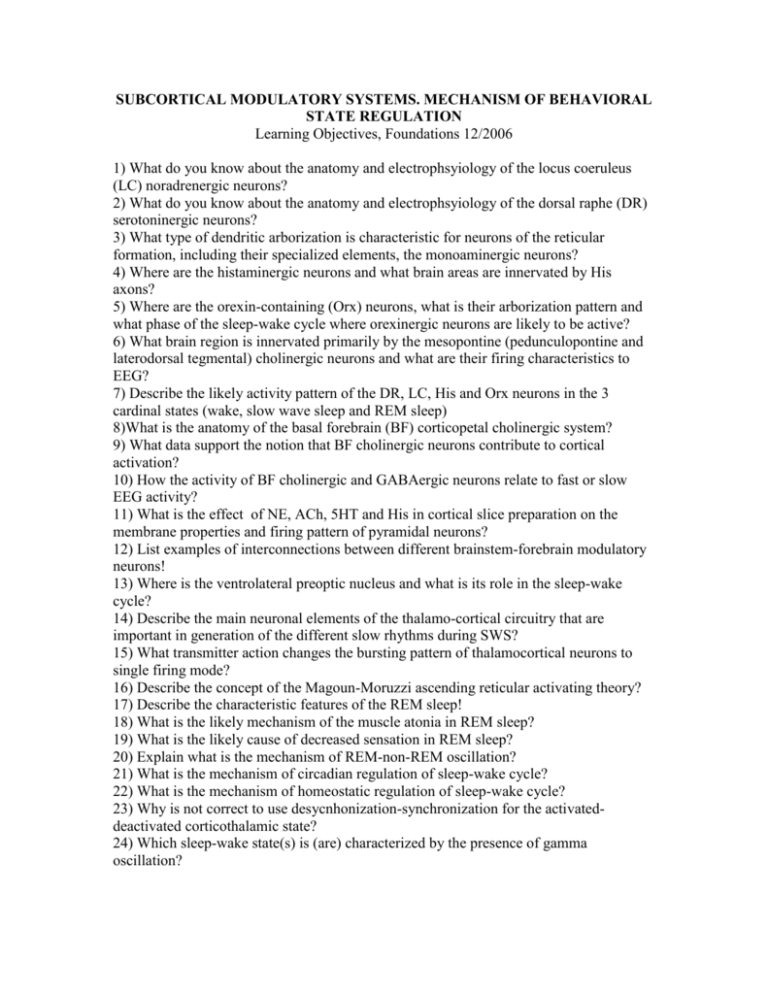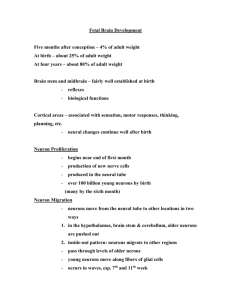Learning objectives
advertisement

SUBCORTICAL MODULATORY SYSTEMS. MECHANISM OF BEHAVIORAL STATE REGULATION Learning Objectives, Foundations 12/2006 1) What do you know about the anatomy and electrophsyiology of the locus coeruleus (LC) noradrenergic neurons? 2) What do you know about the anatomy and electrophsyiology of the dorsal raphe (DR) serotoninergic neurons? 3) What type of dendritic arborization is characteristic for neurons of the reticular formation, including their specialized elements, the monoaminergic neurons? 4) Where are the histaminergic neurons and what brain areas are innervated by His axons? 5) Where are the orexin-containing (Orx) neurons, what is their arborization pattern and what phase of the sleep-wake cycle where orexinergic neurons are likely to be active? 6) What brain region is innervated primarily by the mesopontine (pedunculopontine and laterodorsal tegmental) cholinergic neurons and what are their firing characteristics to EEG? 7) Describe the likely activity pattern of the DR, LC, His and Orx neurons in the 3 cardinal states (wake, slow wave sleep and REM sleep) 8)What is the anatomy of the basal forebrain (BF) corticopetal cholinergic system? 9) What data support the notion that BF cholinergic neurons contribute to cortical activation? 10) How the activity of BF cholinergic and GABAergic neurons relate to fast or slow EEG activity? 11) What is the effect of NE, ACh, 5HT and His in cortical slice preparation on the membrane properties and firing pattern of pyramidal neurons? 12) List examples of interconnections between different brainstem-forebrain modulatory neurons! 13) Where is the ventrolateral preoptic nucleus and what is its role in the sleep-wake cycle? 14) Describe the main neuronal elements of the thalamo-cortical circuitry that are important in generation of the different slow rhythms during SWS? 15) What transmitter action changes the bursting pattern of thalamocortical neurons to single firing mode? 16) Describe the concept of the Magoun-Moruzzi ascending reticular activating theory? 17) Describe the characteristic features of the REM sleep! 18) What is the likely mechanism of the muscle atonia in REM sleep? 19) What is the likely cause of decreased sensation in REM sleep? 20) Explain what is the mechanism of REM-non-REM oscillation? 21) What is the mechanism of circadian regulation of sleep-wake cycle? 22) What is the mechanism of homeostatic regulation of sleep-wake cycle? 23) Why is not correct to use desycnhonization-synchronization for the activateddeactivated corticothalamic state? 24) Which sleep-wake state(s) is (are) characterized by the presence of gamma oscillation? 25) What is the effect of stimulation of the peribrachial (mesopontine) region on thalamic neuronal firing and membrane potential? 26) What is the relationship between sensory processing and sleep-wake cycle? 27) Describe the development of the arousal concepts! 28) Describe events in the thalamocortical, basalocortical and brainstem-thalamic network that lead to activated (aroused) cortical state! 29) What is the sleep switch off and flip-flop sleep theory? 30) What is narcolepsy and what is the likely cause of it?








